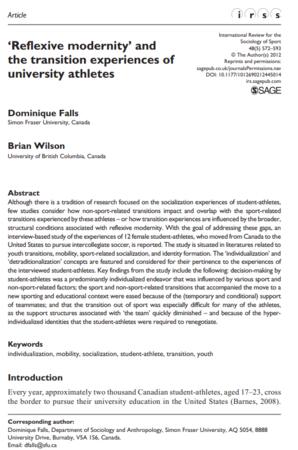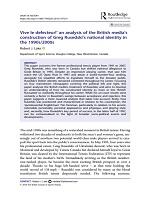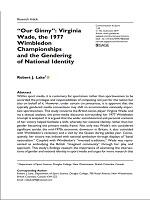Sport Science
Related Works
Content type
Digital Document
Abstract
Background: Exercise testing in children is widely recommended for a number of clinical and prescriptive reasons. Many institutions continue to use the Bruce protocol for treadmill testing; however, with its incremental changes in speed and grade, it has challenges for practical application in children. We have developed a novel institutional protocol (British Columbia Children's Hospital (BCCH)), which may have better utility in paediatric populations.
Aim: To determine if our institutional protocol yields similar peak responses in minute ventilation (VE), oxygen consumption (VO 2 ), carbon dioxide production (VCO 2 ), respiratory exchange ratio (RER), metabolic equivalents (METS) and heart rate (HR) when compared with the traditional Bruce protocol.
Methods: On two different occasions, 70 children (boys=33; girls=37) aged 10-18 years completed an exercise test on a treadmill using each of the protocols. During each test, metabolic gas exchange parameters were measured. HR was monitored continuously during exercise using an HR monitor.
Results: Physiological variables were similar between the two protocols (median (IQR); r s ): VE (L/min) (BCCH=96.7 (72.0-110.2); Bruce=99.2 (75.6-120.0); r s =0.95), peak VO 2 (mL/min) (BCCH=2897 (2342-3807); Bruce=2901 (2427-3654); r s =0.94) and METS (BCCH=16.2 (14.8-17.7); Bruce=16.4 (14.7-17.9); r s =0.89). RERs were similar (BCCH=1.00 (0.96-1.02); Bruce=1.03 (0.99-1.07); r s =0.48). Total exercise time (in seconds) was longer for the BCCH protocol: BCCH=915 (829-1005); Bruce=810 (750-919); r s =0.67.
Conclusion: The BCCH protocol produces similar peak exercise responses to the Bruce protocol and provides an alternative for clinical exercise testing in children.
Origin Information
Content type
Digital Document
Abstract
Although there is a tradition of research focused on the socialization experiences of student-athletes, few studies consider how non-sport-related transitions impact and overlap with the sport-related transitions experienced by these athletes – or how transition experiences are influenced by the broader, structural conditions associated with reflexive modernity. With the goal of addressing these gaps, an interview-based study of the experiences of 12 female student-athletes, who moved from Canada to the United States to pursue intercollegiate soccer, is reported. The study is situated in literatures related to youth transitions, mobility, sport-related socialization, and identity formation. The ‘individualization’ and ‘detraditionalization’ concepts are featured and considered for their pertinence to the experiences of the interviewed student-athletes. Key findings from the study include the following: decision-making by student-athletes was a predominantly individualized endeavor that was influenced by various sport and non-sport-related factors; the sport and non-sport-related transitions that accompanied the move to a new sporting and educational context were eased because of the (temporary and conditional) support of teammates; and that the transition out of sport was especially difficult for many of the athletes, as the support structures associated with ‘the team’ quickly diminished – and because of the hyper- individualized identities that the student-athletes were required to renegotiate.
Origin Information
Content type
Digital Document
Abstract
Tennis featured in every Olympics from 1896 to 1924, after which disagreements between the International Olympic Committee (IOC) and the International Lawn Tennis Federation (ILTF) on matters pertaining to organisational control and the amateur eligibility of players led to tennis being removed from the Olympic Games as a full-medal event until the 1988 Seoul Olympics. This paper traces the steps of the sport’s reinstatement, from when efforts commenced in the 1950s, setting this development in the contexts of: broader political movements, shifting IOC leadership, burgeoning commercialisation of Olympic sport, the concomitant push for professionalisation and the declining influence of amateur ideals within both the Olympic movement and international tennis. Under the leadership of the amateur stalwart Avery Brundage, the IOC stymied attempts to facilitate tennis’s re-entry, challenging both the ILTF on failing to deal with widespread ‘sham-amateur’ practices and the avaricious promoters luring amateur players toward the professional ranks. Brundage and the IOC also strongly condemned the move to ‘open’ tennis and an acceptance of full-blown professionalism. Only a change in leadership, firstly with Lord Killanin and then the progressive reformer Juan Antonio Samaranch, did the IOC recognise the value of tennis within the Olympic movement, which by then had itself become increasingly money-oriented.
Origin Information
Content type
Digital Document
Abstract
The bulk of tennis historiography has tended to project a Southern-centric image of the sport, through descriptions of its clubs and tournaments, its players, and associations. Both the Lawn Tennis Association and the Wimbledon Championships began and have remained bastions of Southern hegemony, but there existed (and continues to exist) a large and active ‘tennis culture’ in the North that has been overlooked. The aim of this paper is to critically explore the notion of a north-south divide in tennis, commencing from the late nineteenth century to the early post-war period. Comparing both northern and southern regions, including Scotland and Wales, it focuses on the emergence of clubs and tournaments, the attitudes, values and behaviours of players and spectators, and the formation of associations. Evidence suggests the existence of a north-south divide, but one that is qualitatively distinct from that experienced in popular team sports; less a reliance on the construction of Northern sporting heroes, with their concomitant representative personalities and characters, and more a focus on the construction of regional stereotypes of clubs, tournaments and players, and the focus on different values, all set in broader historical contexts of rising and waning fortunes of Northern regions in industry and commerce.
Origin Information
Content type
Digital Document
Abstract
This paper concerns the former professional tennis player from 1991 to 2007, Greg Rusedski, who was born in Canada but shifted national allegiance to Great Britain in 1995. Despite an impressive playing career, that saw him reach the US Open final in 1997 and attain a world-number-four ranking, alongside his steadfast efforts to ingratiate himself to the broader public, Rusedski’s British identity remained contested throughout his career. Focusing on four mainstream newspapers covering the political left and right, this paper analyses the British media’s treatment of Rusedski, and aims to develop an understanding of how his constructed identity as more or less ‘British’ fluctuated so markedly throughout his career. While his on-court results were certainly a factor in Rusedski’s swings between acceptance and rejection, this paper suggests a more nuanced analysis that takes into account, firstly, how Rusedski was positioned and characterised in relation to his countryman, the ‘quintessential Englishman’ Tim Henman, particularly in relation to his accent, ostensible personality, personal appearance and physique, and playing style, and, secondly, how Rusedski’s key period of success, in the latter half of 1997, can be contextualised in the light of broader socio-political events and developments.
Origin Information
Content type
Digital Document
Abstract
Within sport media, it is customary for sportsmen rather than sportswomen to be accorded the privileges and responsibilities of competing not just for the nation but also on behalf of it. However, under certain circumstances, it is apparent that the typically gendered media conventions may shift to accommodate nationally important sportswomen. This study concerns the British tennis player Virginia Wade, and via a textual analysis, the print-media discourse surrounding her 1977 Wimbledon triumph is analyzed. It is argued that the wider sociohistorical and personal contexts of her victory helped facilitate a shift, whereby her national identity rather than her gender becoming the primary media frame. Not only was Wade’s win considered significant amidst the mid-1970s economic downturn in Britain, it also coincided with Wimbledon’s centenary and a visit by the Queen during jubilee year. Consequently, her victory was imbued with national symbolism through displays of “banal nationalism.” Coupled with Wimbledon’s “invented traditions,” Wade was represented as embodying the British “imagined community” through her play and approach. This study’s findings reassert the importance of examining the intersections of gender and national identity in sport media and urges for more research that foregrounds historical context as a key factor for female athlete national transcendence.
Origin Information
Content type
Digital Document
Description / Synopsis
Presented at the North American Association for Environmental Education (NAAEE), 2018, Spokane, Washington. The presentation shares research describing features of the learning environment linked to the long-term learning outcome of active citizenship. It tells the story of how the learning environment in a high school integrated studies program contributed to the development of citizens that embrace environmental stewardship and are active contributors to a healthy, sustainable society.
Origin Information
Content type
Digital Document
Abstract
This paper critically examines the life and career of Daniel “Dan” Maskell OBE CBE (1908-92), the much-loved British professional coach and BBC commentator for Wimbledon, and position his social ascendancy during the inter-war and post-war periods within the contexts of shifting class relations in British society, and the professionalisation of tennis and growing performance orientation of amateur tennis authorities in Britain. Given his working-class origins, Maskell’s gradual acceptance into the British lawn tennis fraternity and rise to become “the voice of Wimbledon” and, for some, the personification of traditional British sporting amateur values, was something of an enigma, and reflected key contradictions in what amateurism constituted in the twentieth century. Despite enduring systematic discrimination in clubs and exclusion from amateur competitions, as a consequence of him being a “professional”, he remained a chief proponent of the amateur ideology throughout his lifetime and exhibited numerous personal qualities that endeared him to the upper-middle-class establishment: modesty, loyalty, integrity, conservative views on player behaviour, deference to authority, strong work-ethic, and good-humoured nature. Once tennis went “open” in 1968, and throughout a period when professionalism and commercialism threatened to undermine the sports’ core ideals, Maskell continued to represent and promote amateur ideals through his broadcasting ethics and values.
Origin Information
Content type
Digital Document
Description / Synopsis
Conference presentation delivered at the American Kinesiology Association (AKA) Leadership Workshop, Dallas, Texas (2017, January).
Origin Information
Content type
Digital Document
Abstract
This article examines the lives of the late-nineteenth and early-twentieth-century lawn tennis coaching-professionals, notably Tom Burke, Harry Cowdrey, Charles Haggett and George Kerr. These men, considered equally if not more gifted than the first-ranked amateur players of the period, have received scant attention or recognition, either as “expert” players or for their role as coaches/instructors within the “amateur” game. Ostensibly, these working-class boys/men sought employment in clubs, as ball-boys, groundskeepers, stringers and instructors, but, being immediately classified as “professionals”, were subsequently marginalised within clubs and barred from amateur competitions. Few outside of the club environs encountered them, few observed or learned of their skills, and fewer still reported their exploits. While many of the top amateur players of the period recognised the need for coaching-professionals, the British Lawn Tennis Association (LTA) was intransigent. They staunchly refused to sanction professional competitions in Britain, fearing they would provide a pathway away from amateurism, and propel the amateur to seek remuneration from their tennis. Coaching-professionals had little choice but to remain as “servants” within their clubs, confined by the rigid class system and unyielding amateur ethos. Hitherto largely ignored within lawn tennis historiography, these men are the “ghosts” of lawn tennis past.
Origin Information










